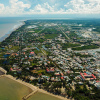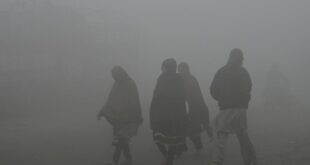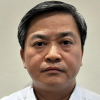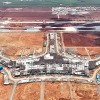Haunted by memories of a 1968 battle in southern Vietnam, two Australian veterans have spent the past two decades searching for the mass grave of 42 Vietnamese soldiers buried in a bomb crater.
Brian John Cleaver left his homeland 56 years ago to fight with allied forces in South Vietnam as part of the 3rd Battalion under The Royal Australian Regiment.
Back then, the 20-year-old man simply thought he was on his way to complete a two-year military service and then return home.
“I didn’t expect to be thrown into a life-and-death, unjust war,” the veteran recalls.
On May 24, 1968, Cleaver’s unit was deployed to establish and defend FSPB Balmoral, a military base in Binh My Commune, Tan Uyen District of Binh Duong Province. The base, located about 40 km from Saigon, was a crucial position to thwart the second phase of the Tet Offensive, a major escalation and one of the largest military campaigns of the Vietnam War, by the Liberation Army.
Simultaneously, the 7th Division, one of the main army units in the southern battlefield of the Vietnamese People’s Army, received orders from the Southern Command to attack the base.
The ensuing battles caused significant losses on both sides.
Cleaver was shocked to witness over 40 bodies of North Vietnamese soldiers being bulldozed into bomb craters, forming mass graves.
The horrific experiences of the battle led him to suffer from post-traumatic stress disorder.
For over 30 years after his discharge, Cleaver tried to conceal his condition, taking various types of medication, yet achieved no improvement.
“I was tormented by the thought that the mass grave would remain unknown, causing great grief to their families,” the veteran said.
In 2002, Cleaver decided to return to Vietnam to search for the burial site of those soldiers, hoping to heal his psychological wounds.
Telling people he was touring Vietnam, the veteran returned to the battlefield, which is now a vast rubber forest.
After identifying the area, he went back to Australia to gather documents and reconnect with old comrades, including Private John Bryant.
“At that time, I didn’t want to mention Vietnam because it was too haunting,” Bryant said.
Just like Cleaver, Bryant initially thought going to Vietnam was simply to fulfill his military duty.
At 22 in 1968, Bryant was a photography enthusiast and always carried a camera to capture beautiful moments of life.
His 3RAR battalion was stationed in Ba Ria – Vung Tau Province but members were usually tasked with supporting other strongholds.
Before the night of May 25, 1968, Bryant had never participated in a battle.
“We were only dropped down by helicopters with water and rations, and then we walked, crawled, or crept… and took souvenir photos,” he recalled.
The battles in Binh My were truly beyond the imagination of young men like Cleaver and Bryant at that time.
In the May 26th battle, Vietnam lost six soldiers, and the Australian soldiers dug graves with shovels. Two days later, the fight intensified, resulting in 28 North Vietnamese soldiers being placed into bomb craters and covered over.
Many of Bryant’s comrades were also killed or wounded. The horrific memories haunted him, so he turned down Cleaver’s offer to return to Vietnam to find the mass grave, and only stopped at giving Cleaver some old photos he took during that summer in Vietnam.
With the gathered documents, Cleaver got back to the old battlefield in 2003 and started digging. His daily search in the rubber forest caught the attention of locals, and the Binh My militia reported it to the district and then the provincial authorities.
 |
|
Brian John Cleaver digs a hole to search for the remains of fallen Vietnamese soldiers in a rubber forest of Binh Duong Province in 2013. Archived photo |
Lieutenant Colonel Le Hoang Viet, then the Head of the Policy Department of the Binh Duong Military Command, responsible for collecting martyrs’ remains, was assigned to communicate with Cleaver.
“Initially, he didn’t dare say he was searching for graves, and only claimed to be visiting old battlefields,” said Viet.
However, upon learning that the Vietnamese side also wanted to collect martyrs’ remains, he revealed his true purpose.
After that day in 2003, Viet became Cleaver’s companion for over a decade.
Every dry season in the southern region, from December to April, Cleaver would fly from Australia to Binh My, using his own budget to hire workers, machinery, and radar to search several hectares of rubber forest.
In 2005, the Australian Ministry of Defense, through the Australian Embassy in Vietnam, provided the Binh Duong Military Command with two maps indicating the coordinates of two mass graves of Vietnamese soldiers killed on May 28, 1968 battle at the Balmoral base.
The Binh Duong Military Command conducted eight searches over more than 90 hectares in Binh My and Hoi Nghia communes, using various methods like digging with shovels, picks, and excavators, studying maps, and using radar and satellite imagery. Despite eight searches, only one set of remains was found.
According to Lieutenant Colonel Viet, after unsuccessful searches, many wanted to give up, but Cleaver persisted though he was “very sad” about the situation.
Enforcement
In 2007, though the search had not yielded results as hoped, Cleaver’s determination gradually changed his comrade John Bryant. That year, Bryant set foot in Vietnam again after almost four decades.
“The openness, friendliness, and willingness to move past the war of the Vietnamese people and government touched me,” Bryant described his feelings the first time he got back since the war.
This made him return to Vietnam many times after that. In 2009, he participated in Cleaver’s search efforts as an observer, occasionally providing suggestions when excavations were unsuccessful.
More than once, Bryant told Cleaver that the location he identified was wrong. On the night of the battle, Bryant was on guard duty and had taken photos around the battlefield, so he was certain the grave was 400-500 meters away from Cleaver’s search area.
He identified the location by using a gun emplacement, then moving straight ahead by around 80 meters.
According to Lieutenant Colonel Le Hoang Viet, Bryant’s assessment was correct but was initially overlooked. The search team had overly relied on existing documents, and Bryant was only involved as an old friend of Cleaver.
In 2019, after exhausting all efforts, digging, and searching over several hectares of rubber forest, Cleaver decided to stop.
“At that moment, he cried and said: ‘I’m sorry for everything’,” Lieutenant Colonel Viet recalled.
It was that moment that Bryant jumped in and disagreed. He continued the search.
“I prepared all the documents and knocked on many doors to continue the work my comrade left behind,” said Bryant. Initially, the Australian Embassy was hesitant because Vietnam had put much effort into searching with Cleaver for 16 years but to no avail.
However, when Bryant presented evidence and explained that the previous search area was merely an assembly point and the battle location, and the grave had to be half a kilometer away, they were convinced and resumed support.
This time, Bryant was aided by Luke Johnston, the son of an Australian veteran who also fought in Vietnam.
At 43, Johnston had lived in Vietnam for 10 years by 2019.
His childhood was marked by seeing his father cry and fear fireworks. In adulthood, he learned about his father’s war experiences and trauma. Wanting to heal his father, he did everything he could to support the search.
Johnston first came to Vietnam in 2009 and spent two months traveling the country by motorcycle, filming the beautiful scenery and friendly people to show his father. His excitement helped ease his father’s psychological burden. After that, he returned to Vietnam every year.
 |
|
Luke Johnston (L) and Duncan Reid, Assistant Defense Attaché at the Australian Embassy in Vietnam during a search mission in a rubber forest of Binh Duong Province. Photo by Nguyen Xuan Thang |
After his father passed away in 2016, Johnston decided to settle in Vietnam, adopting the Vietnamese name “Luc,” and continued researching his father’s unit. During this time, he met Bryant and agreed to help search for the mass grave of North Vietnamese soldiers in Binh Duong.
In 2020, Bryant had planned to returnto Vietnam to continue the search, but the Covid-19 outbreak forced him to postpone. Meanwhile, Luc stayed in Binh Duong, renting a house and spending months traveling back and forth Binh My.
With data collection skills, combining with Bryant’s evidence and modern equipment, Luc eventually located the gun emplacement Bryant first mentioned.
“I immediately informed John, feeling truly happy,” Luc said. From there, he enlisted Glen Hines, an American expert in locating missing soldiers, to confirm the coordinates.
When the border restrictions were lifted, Bryant immediately flew to Vietnam, and the team completed a detailed report for the Australian Embassy.
Late last year, the mass grave of Vietnamese soldiers was identified in Cho Dung hamlet of Binh My commune.
Closure
On March 13, the 515 Steering Committee of Binh Duong, which is in charge of searching for and repatriating martyrs’ remains, conducted the ninth search.
Over 20 days, the team found about 20 sets of remains with personal belongings, some inscribed with names. They were identified as Vietnamese soldiers who fell during the battle that Cleaver and Bryant once joined.
On April 26, Binh Duong People’s Committee held a memorial service for 20 martyrs at the provincial martyrs’ cemetery.
 |
|
Australian veteran John Bryant (C) holds family members of Vietnamese soldiers killed during the May 26th, 1968 battle at a ceremony held in Binh Duong Province on April 26, 2024. Photo by VnExpress/Dinh Trong |
The ceremony was attended by former President Nguyen Minh Triet, the Australian Embassy, foreign veterans, and the martyrs’ families. Local leaders appreciated the Australian veterans’ assistance over the 20-year search.
“At the memorial service, I was truly moved and felt my work was meaningful,” Luc said.
With his data collection expertise, he plans to continue assisting organizations in finding the remaining graves.
Cleaver and Bryant, haunted by the past battle, have to some extent found some solace.
- Reduce Hair Loss with PURA D’OR Gold Label Shampoo
- Castor Oil Has Made a “Huge” Difference With Hair and Brow Growth
- Excessive hair loss in men: Signs of illness that cannot be subjective
- Dịch Vụ SEO Website ở Los Angeles, CA: đưa trang web doanh nghiệp bạn lên top Google
- Nails Salon Sierra Madre
 VnExpress News The News Gateway of Vietnam
VnExpress News The News Gateway of Vietnam





